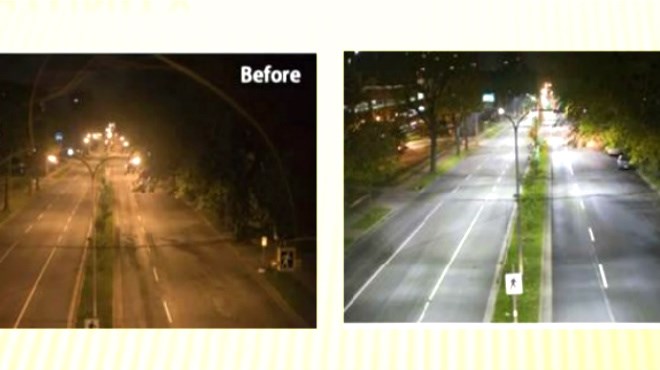Meeting Tuesday, members of the operations committee were reluctant to support an ambitious plan to convert all of the city's 14,627 streetlights to brighter, more energy efficient LED lights.
A staff report on the project said the conversion would cost about $8 million, to be funded from existing reserve funds. That money would be paid back to reserves over nine years, through about $700,000 in annual savings in energy costs.
Tony Cecutti, the city's general manger of infrastructure, said 3,000 of Greater Sudbury's streetlights have already been converted to LED, which last an estimated 20 years before having to be replaced. In contrast, the high pressure sodium lights currently in use last about five years.
Since the LED lights are more expensive, however, Cecutti said a mass conversion would save the city money since it's cheaper to do a “bulk program than replace one bulb at a time.”
Other benefits of LED lights include a reduction in light pollution, and the fact they are much brighter than the sodium lights.
“LED lights are a full spectrum of light, so you would see all the colours you would see in daylight,” Cecutti said.
And the Ontario Power Authority is offering a rebate for communities switching to LED lights, worth about $1.8 million if the city moves ahead with a full conversion. That big of a rebate likely won't be available next year, he said.
But the plan has risks. For example, during a smaller conversion program approved in 2012, some structural problems were uncovered with the old lights that increased costs.
“And we know there are some areas that have insufficient lighting, and we may want to add in some areas,” Cecutti said.
And when faced with lower revenue from the city, Greater Sudbury Utilities changed its fee structure, increasing fixed costs and relying less on revenue from actual energy consumption.
City staff wanted approval to issue an RFP to find a contractor that would prepare a business case for the project, and supply and install the bulbs. If business case analysis came back positively, the plan would be to spend $4 million this year, $4 million next year and $2 million in 2017.
“If there's no incentives, and we can't justify a positive payback, we won't proceed with the retrofits,” he said.
But committee members were reluctant to approve the plan without information on what sort of payback resulted from the 2012 conversion of 1,315 streetlights.
Ward 12 Coun. Joscelyne Landry-Altmann said it “boggles the mind” that staff would seek approval without providing information on the previous retrofit. Without it, she said there were too many unanswered questions to approve such a big expenditure.
“I would hope to have that information,” she said. “Without benefit of that information, Mr. Cecutti,” she couldn't support the project.
And Ward 10 Coun. Fern Cormier said with councillors trying to freeze taxes this year, it may be the wrong time for the project.
“There's wants and needs,” Cormier said. “And right now over the next 12 months we're going to have to focus on our needs.”
But Cecutti said that by not proceeding, the city risked losing the $1.8 million in rebates. And an analysis would be conducted first before the money is committed to ensure the payback estimates were realistic.
“We're not recommending the full implementation unless the business case is positive,” he said. “If the payback is there, then it makes sense to proceed.”
In the end, the committee opted to defer a decision until the Feb. 10 city council meeting, to give staff time to prepare a report on the 2012 retrofit.
Join Sudbury.com+
- Messages
- Post a Listing
- Your Listings
- Your Profile
- Your Subscriptions
- Your Likes
- Your Business
- Support Local News
- Payment History
Sudbury.com+ members
Already a +member?
Not a +member?
Sign up for a Sudbury.com+ account for instant access to upcoming contests, local offers, auctions and so much more.
